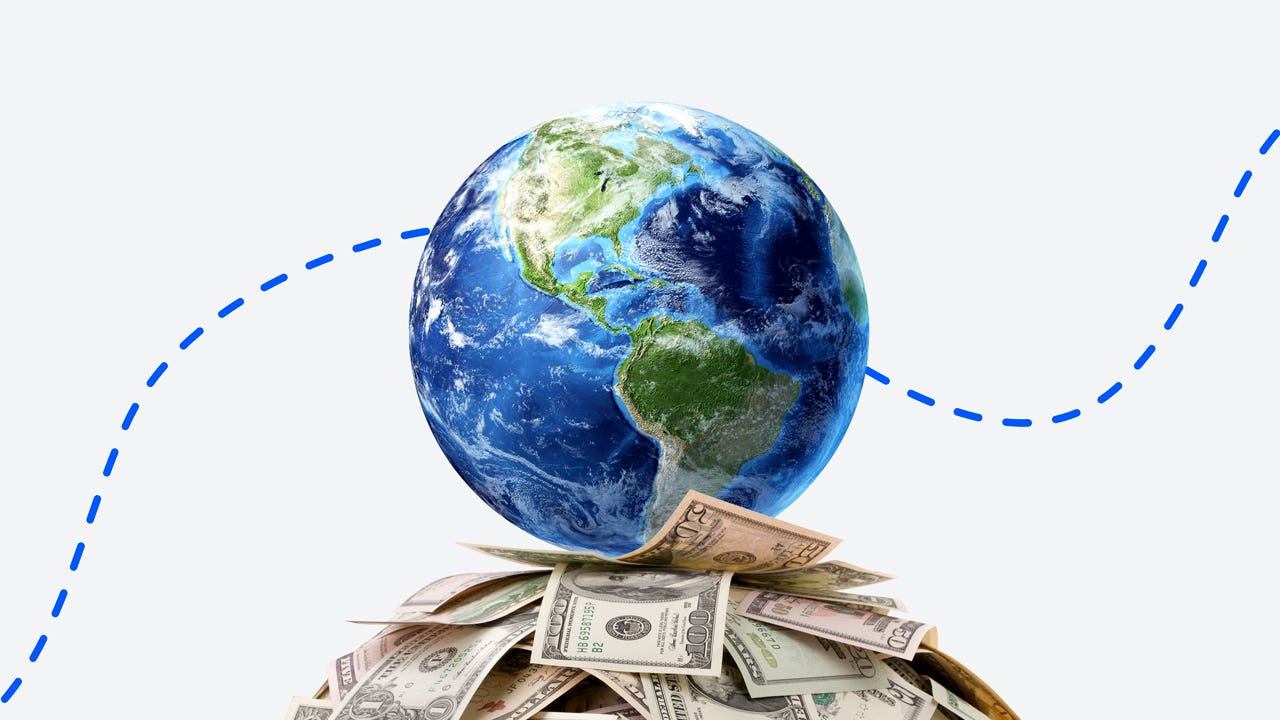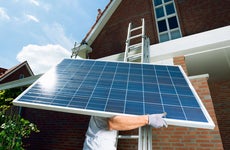12 ways to take an Earth Day approach with your finances

The Bankrate promise
At Bankrate we strive to help you make smarter financial decisions. While we adhere to strict , this post may contain references to products from our partners. Here's an explanation for .
Environmentalists and policymakers have called climate change one of the most significant issues of our time. With it comes threats to food systems, ecosystems and livelihood for billions of people — and a growing share of Americans are starting to favor protecting the environment over the economy, according to a Gallup poll from April.
Yet, consumers might not realize that they can make a difference in the environment simply by thinking twice about how they manage their money, including where they bank, work and invest.
“We can strive to be good stewards of both personal finances and the planet at the same time,” says Mark Hamrick, Bankrate senior economic analyst and Washington bureau chief. “The decisions and actions we take as consumers and investors, for example, help to dictate our impacts on the environment.”
Here’s how you can manage your wallet in a way that supports the environment — from banking and budgeting to spending, housing and investing.
1. The easiest of all options: Go paperless with electronic transactions and e-statements
When it comes to going green with your finances, start with something simple: Limit your paper trail.
Take a close glance at your finances and make a list of all the financial institutions you regularly use. At the top of the list are banks, credit card and utility companies. Consider opting in to paperless statements across all of those firms, so you can receive any bills or notices over email or through an app. You might also end up saving money in the process, given that some institutions charge customers $1 to $5 a month for receiving statements in the mail.
“Anything you can throw into the cloud rather than printing and saving, that’s going to be a win for Earth Day,” says Kacie Swartz, CFP, senior wealth manager at Stone Wealth Management, who specializes in finding environmentally sustainable and socially responsible finance strategies.
Along the way, consider sticking to electronic transactions as much as possible and using a credit or debit card instead of checks. You might also find success in using digital payment services such as Zelle or Venmo if you’re trying to pay an individual.
2. Find a bank that cares about the environment – or better yet, go local
Many of the nation’s largest depository institutions are now vocalizing a commitment to sustainability. JPMorgan Chase, for example, announced in 2020 an ambitious plan to fund $2.5 trillion over the next 10 years to address climate change and contribute funds to sustainable development. Bank of America also said it became carbon neutral in 2020. In 2021, Citi announced plans to phase out financing coal power companies within the next two decades.
Yet, some of the nation’s depository institutions might still invest in less environmentally friendly practices, such as coal mining pipelines or oil rigs. Remember the 101 of banking: Parking your cash in a savings account or certificate of deposit (CD) in any financial institution essentially acts as a loan for the bank. If you want part of your dollars to go toward funding environmentally friendly projects, make sure your financial institution aligns with your goals.
In some cases, going local might be the best route, particularly if you’re worried about protecting the area where you live, which could include doing business with a credit union or local bank.
“Consumers could move the majority of their money from a big bank into a credit union,” says Nate Nieri, CFP, a financial planner at Modern Money Management that specializes in socially responsible investing (SRI). “Local credit unions that are really built for communities, all the money that is built into them goes right back out into the community.”
3. Consider online banks – and make more money along the way
You might find that banking with an online depository institution is the best route of all, simply because they maintain a smaller overhead and carbon footprint by not operating individual branches. You’ll also generally receive more bang for your buck, with online banks offering higher yields on your cash.
If the environment is your first concern, perhaps you’ll want to select a place that’s sustainability-minded. That could be an institution like Limelight Bank, the online division of Capital Community Bank, though, it only offers CDs.
As always, shop around for an account with the best rate and terms that suit your individual financial situation.
Limiting your trips to depository institutions by using their online portal instead to keep track of your transactions could also help reduce your bank’s carbon footprint.
4. Thrift your family’s wardrobe or household goods
Visiting your local consignment shops or yard sales for everyday items from furniture to clothing can be both environmentally friendly and financially rewarding.
The fashion industry contributes 10 percent of all of the world’s carbon emissions, according to a 2018 United Nations report.
No new resources are needed to produce that couch or those jeans you just snagged at your local thrift store. All of that means, you’re reducing waste.
“If you’re buying secondhand, you’re not contributing to landfills by buying something new and throwing it away,” Nieri says. “And by donating, instead of throwing something away, you keep it out of the landfill. We kind of refer to it like circular purchasing.”
5. Set aside a ‘green’ fund for new energy-efficient appliances or additions
A sustainable reason for holding back on nonessential spending: You might free up extra cash that you can allocate for more pro-environment purchases.
Conscious consumers should consider opening up a separate savings account for a “green” fund. You can use that money to save up for things like energy-efficient appliances for your home, solar panels for your backyard or even an electric vehicle. Those purchases can also be as simple as replacing your home’s light furnishings with LED bulbs.
“Some of the things that you can do to your home to make it more energy efficient are frequently something you might need to save up for,” Stone Wealth’s Swartz says.
Though some energy-efficient products and appliances might be more expensive, they can save you money in the long run. Energy Star reports that its clothes washers, for example, use 25 percent less energy and 33 percent less water, translating to $370 in savings. You might even be able to “recycle” those extra savings back into your green fund. The more items you replace, the bigger your savings will likely grow. For example, the average family could save $500 a year if they make six key Environmental Protection Agency (EPA)-backed home upgrades, which include buying an Energy Star water heater and an electric-vehicle charger for your home.
“Every American can make a difference in protecting our climate with the choices they make at home — and they can save money while they are at it,” said EPA Administrator Michael Regan in a February statement. “If every household took the actions outlined in the Energy Star Home Upgrade, the U.S. could cut its residential annual energy use up to 20% by 2050.”
6. Reduce your energy consumption
Another low-hanging fruit for both saving money and helping the environment: Limiting your electricity usage.
It’s more than just turning off the lights when you leave a room. It is also making sure you don’t leave on any appliances that continue to hog energy even when they’re idle. Those include toasters, hair dryers and flat irons, as well as coffee pots, microwaves, televisions and toaster ovens. Even mobile phone chargers that stay plugged in can guzzle energy — 0.26 watts when your phone is disconnected and 2.24 watts when your phone is hooked up yet fully charged, according to the Department of Energy (DOE). A simple rule of thumb? If it leaves a light on while it’s idle, it’s using energy.
It all adds up along the way — in some cases, an extra $100 to 200 a year, depending on how many appliances you have, according to the DOE. Overall, those so-called energy vampires make up about 5-10 percent of all U.S. electricity usage, the agency also finds. In a high inflationary period where energy prices rose 32 percent from a year ago, every little bit of effort you take to reduce your usage will help.
7. Cook at home more
You might also benefit the environment by cooking at home during the week, which can help cut back on single-use plastics used for takeout and reduce the money you spend on food away from home. (Consumers in 2021 spent an average of nearly $308 on food away from home, according to the Department of Commerce.) Transportation in 2019 made up 29 percent of U.S. greenhouse emissions, according to the Environmental Protection Agency.
8. Make some money with a ‘green’ side hustle
Have some extra time on your hands that you might want to put toward helping the environment? Consider finding an environmentally friendly side hustle. Earning extra income on the side of your full-time job has been a common move, with a Bankrate survey from June 2019 finding that 45 percent of all U.S. workers had a side hustle.
Those gigs could be as simple as removing junk for neighbors or creating a composting service. If you’re feeling creative, you could consider turning someone’s unwanted items into artwork. Similar to thrifting your wardrobe, even selling your old clothes can be an easy — and wallet-friendly — side hustle.
9. Bring your own utensils and bags
Those plastic water bottles you buy at the grocery store? If you go with a reusable bottle instead, you’ll likely save on costs while also helping the environment. Ordering a drink at your local coffee shop? Bring in your own mug. Sometimes, establishments even offer incentives to reduce waste. Starbucks, for example, offers a 10-cent discount to customers who bring their own coffee cup.
10. Adjust your commute
More than two years after the coronavirus pandemic shut down offices and workspaces, many consumers are still finding themselves working from home for part, if not all, of the week. That will go miles in helping to reduce your own individual carbon footprint — not to mention, the money you could save on gas, which has also been among the hardest consumer categories hit by record-high inflation. Better yet, see if you can limit your business travel by opting into more virtual meetings and conferences.
11. Look out for tax credits and other money-making opportunities that can reward you for sustainable decisions
If saving more money on energy costs and helping the environment aren’t incentive enough, you might be able to claim tax credits and other tax-advantaged opportunities at both the state and federal level simply by “green-ifying” your home.
Those tax credits range from the well known to the obscure. One such example: claiming the nonbusiness energy property tax credit can help offset up to 10 percent of costs of up to $500 on certain residential appliances from Energy Star, a joint program through the EPA and the DOE. You can also claim certain tax breaks and credits for donating old clothes to charities, owning electric vehicles or making home-improvement purchases.
Those opportunities could also be expanding, if President Joe Biden’s Build Back Better infrastructure bill comes to fruition. For example, the bill includes a $900 tax credit for purchasing an electric bike.
If you own property, consider participating in one of the U.S. Department of Agriculture’s various environmental assistance programs, such as the Conservation Reserve Program (CRP) that pays a yearly rental payment in exchange for farmers removing environmentally sensitive land from agricultural production. There might be more options exclusive to your area.
Work with a tax expert and financial planner to help you track down all that could be out there for you.
12. Funnel your investing dollars into environmentally conscious companies, but beware of the fine print
One way of evaluating potential investments has gained traction within the money-management industry in recent years. It’s known as environmental, social and governance (ESG) investing, and experts say you can still make just as much through this form of SRI as you can with any other portfolio. You can invest in individual companies making ESG a priority; you can also invest in a mutual fund or exchange-traded fund with a pre-packaged group of securities.
“Our research shows that you don’t sacrifice any performance if you’re in a diversified fund that has different holdings in different asset classes,” says Michael Taylor, CFA, investment strategy analyst for the Wells Fargo Investment Institute who specializes in the topic.
The Earth Day approach would be focusing on the E aspect in ESG, Taylor says, though a company with pro-environmental policies is also bound to have some social or governance causes it’s focused on as well. “It’s fluid and not siloed,” he says.
If you’re an impact-minded investor, start by evaluating individual companies or index funds of which you’re interested in investing. At the Investment Institute, Taylor often references a 5-point rating scale, with a 1 being assigned to a company that makes no or minimal consideration of ESG factors and a 5 being designated for an ESG leader or pioneer. But every institution does it differently, and you might benefit from working with a financial advisor who has a strong lay of the land.
But above all: Be cautious and don’t trust what companies say at face value. Some companies might claim to be involved in a green initiative, though they allocate minimal cash toward the investment or act as if it isn’t a priority — what’s known as greenwashing.
Be sure to research the firms you’re invested in, understand what they’re focused on as a company and how they’re implementing those green priorities. Gather as much information as possible, and talk with a professional if you need more help.
“It becomes a fad,” Taylor says. “Everyone wants to be sustainable. Does that mean they’re actually doing it? You really have to do your due diligence.”
Bottom line
Money talks, and that’s never been truer than with environmental causes. U.S. consumers concerned about the environment may find that there’s no financial step too small to make a difference. And if the impact is broad based enough, experts say it can translate to real change.
“Our daily financial decisions and actions might seem small when thought of relative to the rest of the world, but that’s how change begins,” Hamrick says. “Collectively, the impacts grow when they’re adopted by more individuals. Whether it is buying used clothing, opting for greener options in transportation, such as walking, riding a bicycle, taking mass transit or driving an electric vehicle, one can decide to save money and help the planet.”
Related Articles



